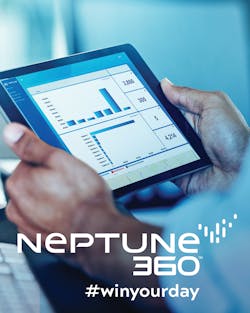Water Connections: Confidently Manage, Share, and Secure Your Data
Software-as-a-Service lends deeper understanding
With Software-as-a-Service (SaaS) water utilities can gain a deeper understanding of the data they collect while also managing, sharing and securing that information more easily. With SaaS, a utility can gather and analyze more data from more sources to empower faster, more informed decisions.
Build on Capabilities as
Needs Change
A software application that grows with the utility can be a major advantage. The move from mobile meter reading to an AMI network, and beyond, can be virtually seamless with SaaS. A modular-based platform makes it simple to turn on new features as needs evolve without the need for IT support. A SaaS solution also affords more freedom to build upon existing assets, when and where needed. The total cost of ownership is typically lower with SaaS than on-premise server deployment, with less strain on limited budgets and IT resources.
Share and Analyze Data
With cloud-based SaaS, utilities can share and leverage large volumes of data, empowering collaboration and helping predict impacts. This type of platform can utilize APIs (Application Programming Interfaces) to seamlessly integrate meter data, event data, and alerts directly with existing systems or applications, such as work order systems, customer portals, billing systems, or hydraulic modeling applications.
Field personnel can share information directly with water consumers, responding to high water bill complaints and showing the time and date when a possible leak started. Usage for individual accounts is easily translated into simple graphs and charts that can be emailed. In addition to pinpointing locations of possible leaks, backflows, or unauthorized water consumption, a utility can analyze a specific customer’s consumption activity history for reverse flow conditions or unexplained continuous flows. Trending chart views illustrate usage for a given time span and customer service calls can be resolved with confidence.
Through detailed reporting a utility can stay on top of issues that could impact revenue. Users can quickly identify areas of concern or look for trends to maximize operational efficiencies, plan rate structures, and implement usage initiatives. The information collected can help reduce non-revenue water and aid utility conservation initiatives.
Secure Data That You Own
A subscription-based solution can free a utility from having to host and update software and worry about server maintenance and data security. Data is stored in the cloud, backed by a large-scale data center with staff to identify, deter, and combat cyber threats. A SaaS solution provides a single source of secure, accurate data entry and access for all meter reading system types — AMR, AMI or hybrid.
The software is hosted and managed by a third party, with no installation required. All that’s needed is an Internet browser to log on and access data anywhere, at any time. SaaS removes the burden of implementing disaster recovery plans, leaving coordination and resolution to the data center.
Reduce Truck Rolls, Eliminate Specialized Devices
Water utilities no longer have to send meter readers out for weeks at a time to capture data. When personnel go to perform a radio frequency test for signal strength or exception readings on site, they can do so using their existing Android or iOS cell phones or tablets for those tasks. They can then connect to the cloud and sync up stored data online, in real time, without having to go back into the office.
With SaaS technology, utilities can concentrate on providing consumers with clean drinking water. Win your day for your utility using a cloud-based SaaS platform. WW
Learn more about Neptune’s SaaS solution, Neptune® 360™, at neptunetg.com/neptune360.
